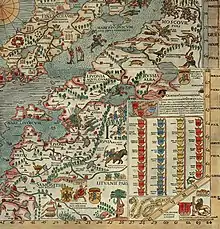
Žaltys and the Holy Fire are depicted in Olaus Magnus' Carta Marina, above the inscription LITVANIE PARS

Parade belt of an officer of the Lithuanian Army, decorated with Žaltys ornaments.

Monument of Žaltys in Vyžuonos
A žaltys (Lithuanian pronunciation: [ʒɐlʲˈtʲǐːs], literally: grass snake) is a household spirit in Lithuanian mythology. As sacred animal of the sun goddess Saulė,[1] it is a guardian of the home and a symbol of fertility.[2] People used to keep it as a pet by the stove or other special area of the house,[1] believing that it would bring good harvest and wealth.[2] Killing žaltys was said to bring great misfortunes upon the household.[1] If žaltys was found in the field, people gave it milk attempting to befriend the creature and make it a sacred household pet.[3]
See also
References
- 1 2 3 Doniger, Wendy (2006). "Žaltys". Britannica Encyclopedia of World Religions. Encyclopædia Britannica. p. 1160. ISBN 1-59339-491-8.
- 1 2 Kiškienė, Elena (2008-05-09). "Uteniškių keiksmai". Šiaurės Atėnai (in Lithuanian) (892).
- ↑ Conway, D. J. (2001). Magickal, Mystical Creatures (2nd ed.). Llewellyn Worldwide. p. 128. ISBN 1-56718-149-X.
This article is issued from Wikipedia. The text is licensed under Creative Commons - Attribution - Sharealike. Additional terms may apply for the media files.